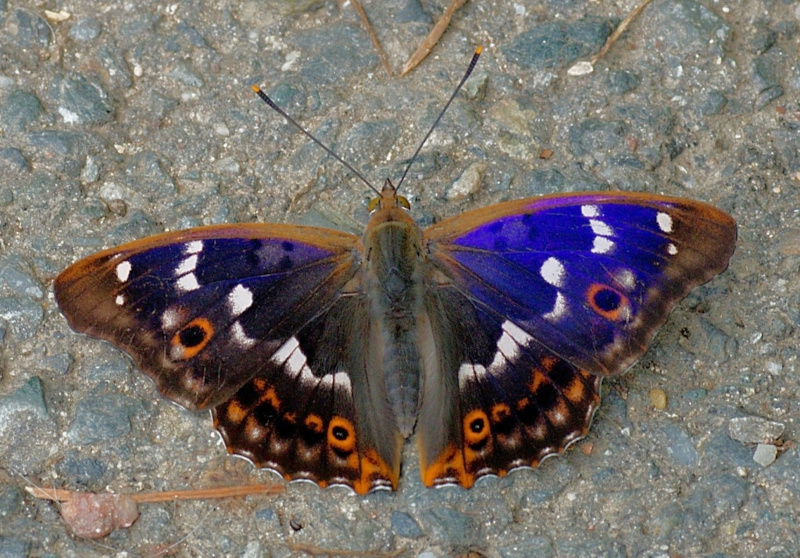
Lesser Purple Emperor Facts
- This gorgeous creation of Nature and evolution most frequently goes by the highly descriptive and informative common name of the Lesser Purple Emperor. For the moment, the amazing Lepidoptera holds no other accepted general appellation.
- Inside of the scientific community, however, the amazing insect does have another title by which it’s known. Thankfully, though, that’s an extremely simple one for the layperson to pronounce. That’s because it has the technical designation of Apatura ilia.
- It received that epithet due to the efforts of two men. Johann Nepomuk Cosmas Michael Denis was an Austrian catholic priest and Lepidopterist. Ignaz Schiffermüller was also an Austrain naturalist and professional in the same field of specialization.
- Together, the uniquely complimentary duo accomplished the first official recognition of the natural marvel as a completely separate and distinct species. Impressively, though, this scientifically noteworthy actually occurred back in the year 1775.
- Pleasantly, the lovely Lesser Purple Emperor appears to be maintaining a population base that’s both stable and sufficient. That enjoyable condition further seems to hold true throughout its entire range. The IUCN therefore now lists its as Least Concern.
- The delicate invertebrate nonetheless still faces several potential threats to its continued existence as a species. Most of these stem from the actions of mankind. They include the dangers of habitat loss and degradation, and of course, climate change.
Related Articles
Lesser Purple Emperor Physical Description
The deceptively-named Lesser Purple Emperor deserves the appreciation and admiration it receives from those who view it. The creature does so, in part, despite the implication that it’s in some manner inferior to its namesake. This biological marvel stands on its own merits.
In terms of physical attributes, it also follows a pattern quite common to its many relatives around the globe. That’s in the fact that it displays a certain degree of the physiological characteristic known as sexual dimorphism. It displays this trait in two ways, however.
In terms of sheer size, males of the species attain a slightly greater average wingspan than their female counterparts. This averages roughly 2.4 – 2.8 in (6.1 – 7.1 cm). Meanwhile, the wingspan of the females reaches a mean width of approximately 2.2 – 2.4 in (5.6 – 6.1 cm).
The body of the Arthropod presents the same general shape as most of its kindred. This consists of an elongated design, covered with a coating of short hairs. In both genders, this typically manifests a dark gray shade. It also has two extremely long antennae on its head.
It’s in terms of its general appearance, though, that the sexes of the Lesser Purple Emperor display the greatest degree of gender-based differences. In males, however, the upper side of both sets of wings mainly shows as brilliant metallic purplish-blue shades.
The rest of its upper wings generally display a border of light shades of light brown or tan. Mulitple spots of white also frequently appear, of varying shapes and sizes. Yet, in contrast, the underside of the wings most commonly displays an overall light-to-dark brown hue.
Females, though, show a significantly different pattern of coloration. For her, this consists primarily of an overall pattern of shades of brown. This covers the entirety of both sets of wings, on both the upper and lower sides. She does display the same pattern of spots.
- Kingdom: Animalia
- Phylum: Arthropoda
- Class: Insecta
- Order: Lepidoptera
- Family: Nymphalidae
- Genus: Apatura
- Species: A. ilia
Lesser Purple Emperor Distribution, Habitat, and Ecology
The magnificent Lesser Purple Emperor evolved as endemic to a comparatively broad swathe of the earth’s surface. The full extent of that zone of habitation might startle many of you, though. That’s true since it developed as native to parts of both Europe and Asia.
The intrepid insect appears in most parts of Europe, though it’s absent from most of the Mediterranean islands. It’s also absent from the more southerly sections. In Asia, it lives throughout most of what’s known as the Palearctic region. That extends as far as Japan.
It additionally displays decidedly strong preferences regarding its choice of habitat. Lamentably, this has the effect of severely restricting its possible avenues of expansion. As a general principle, the remarkable Arthropod makes its home in areas of forest or woodland.
Yet, the creature also requires other conditions, as well. These include relatively close proximity to very damp areas, such as creekbanks, and around rivers. The insect also displays a preference for locations with altitudes between 1,969 – 3,281 ft (600 – 1,000 m).
The stunning Lesser Purple Emperor typically flies from between the months of May to September in most parts of its range. During this period, either one or two generations may develop. This again depends upon what part of its range the individuals resides in.
Like others of its many relatives, it evolved as herbivorous in nature. Caterpillars consume the foliage of various trees, most especially poplars and willows. Adults of this particular species, however, primarily feed on the sugar-rich honeydew secreted by aphids.
Species Sharing Its Range
Check out our other articles on 7 Intriguing South Carolina Insects, Eurasian Brown Bear, Great Barrier Reef, Great Rhododendron, Spinetail mobula, Brown Mantis, Philippine sailfin lizard
